Last season in the second leg of the Championship, Norwich City and Derby County locked horns in a seven-goal thriller with the away side securing all three points. Both teams have demonstrated their fast-pace attacking football that saw many chances being created. The Premier League witnessed another thrilling clash when Daniel Farke and Frank Lampard went head-to-head.
After their triumph in the Championship, Norwich was heading into the new season with positive reactions and high confidence. Besides youth signings to bolster their ranks, they also brought in five new names for the first team. Their opening match against Liverpool didn’t exactly go in their favour, but they turned things around by securing a 3-1 win over Newcastle United.
This summer, Chelsea saw a transfer embargo being placed on them and it prevented the club from adding new players. But with the club legend Frank Lampard as their new manager, the fans expected to see an entertaining style that involved the likes of Mason Mount and Tammy Abraham. They demonstrated what Lampard intended to do when they travelled to Norwich. After the sides each struck two in the first half, Abraham completed his brace to seal the match for Chelsea.
This tactical analysis will provide an analysis of Chelsea’s 3-2 win over Norwich City. Meanwhile, using statistics, we will point out the positives that Norwich’s tactics showed against Chelsea’s tactics.
Lineups
The home side went for Farke’s favourite 4-2-3-1 formation in this match. New signing Ibrahim Amadou remained doubtful as he lacked match fitness. Another addition that didn’t join up with the squad was Josip Drmić. The Swiss striker is expected to return in late August alongside club captain Christoph Zimmermann.
Farke continued to link up the attacking trio of Todd Cantwell, Emi Buendía and Teemu Puuki upfront. They were supported by Jamal Lewis and Max Aarons out wide and Moritz Leitner and Tom Trybull centrally. After making a quick appearance in Norwich’s win over Newcastle, Sam Bryam was registered on the bench alongside Kenny McLean and Mario Vrančić.
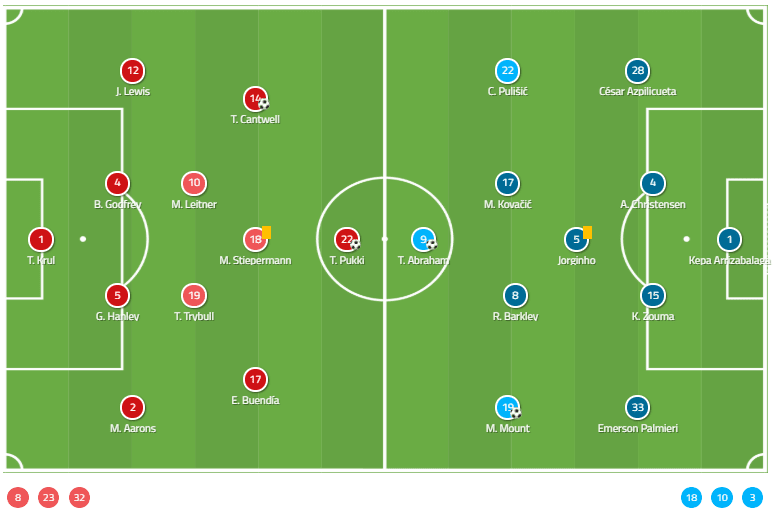
Long-term injuries for Callum Hudson-Odoi and Ruben Loftus-Cheek meant they won’t return to the side until September and January respectively. Reece James’ ankle problem will keep him out until November, while Antonio Rüdiger was expected to join up with the rest in late August.
While N’ Golo Kanté remained a doubt after their UEFA Super Cup match, Lampard kept Jorginho and Mateo Kovačić in his midfield three. Ross Barkley completed the trio while Mason Mount occupied the left-hand side in his 4-1-4-1 formation.
Norwich’s style of play
Despite being an underdog in this match, Norwich didn’t show their shyness when approaching the opposition. They were confident in pressing Chelsea right inside their half and aimed to recover possession high up the pitch.
By forming two separate pressing lanes, the players were able to put pressure on Chelsea’s build-up inside the first half. Buendía positioned himself slightly higher than his original position and created the first line with Puuki. Their responsibility was to press the centre-backs and stop the ball circulation occurring between them. The Argentinian midfielder also followed Jorginho in the process, preventing him from creating passing triangles with the two centre-backs.
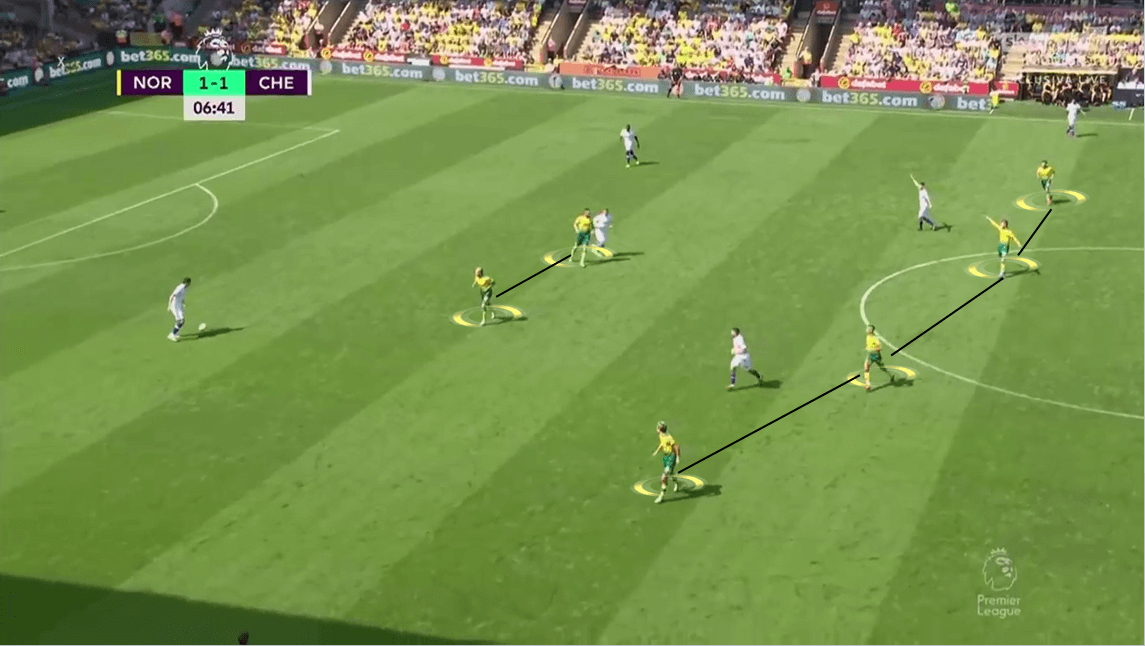
Meanwhile, Stiepermann dropped from his position to occupy Buendía’s right-hand side and allowed Leitner and Trybull to push up. They created the second line that applied pressure on the overlapping wing-backs and two central midfielders.
The line remained compact below Puuki and Buendía to support them and intercept any through balls coming towards them. They kept Mount and Kovačić in their sight while tracking their runs coming for a passing option or forrays into Norwich’s half. Only when Chelsea’s centre-backs distributed the ball wide, the lines would shift into that area and attempted to create an overload. This allowed them to win numerical superiority over Chelsea and helped them to win the ball more efficiently.
They adopted a man-oriented press and tried to recover possession aggressively. But they also stayed away from unnecessary fouls. When the ball carrier had the ball, there would be two players who closed him down and narrowed the spaces that he had. At the same time, two other players followed the nearest passing options and eliminated his short passes. It forced the ball carrier to pass the ball back to the goalkeeper or he would clear it out of that area and hoped to find a teammate upfront.
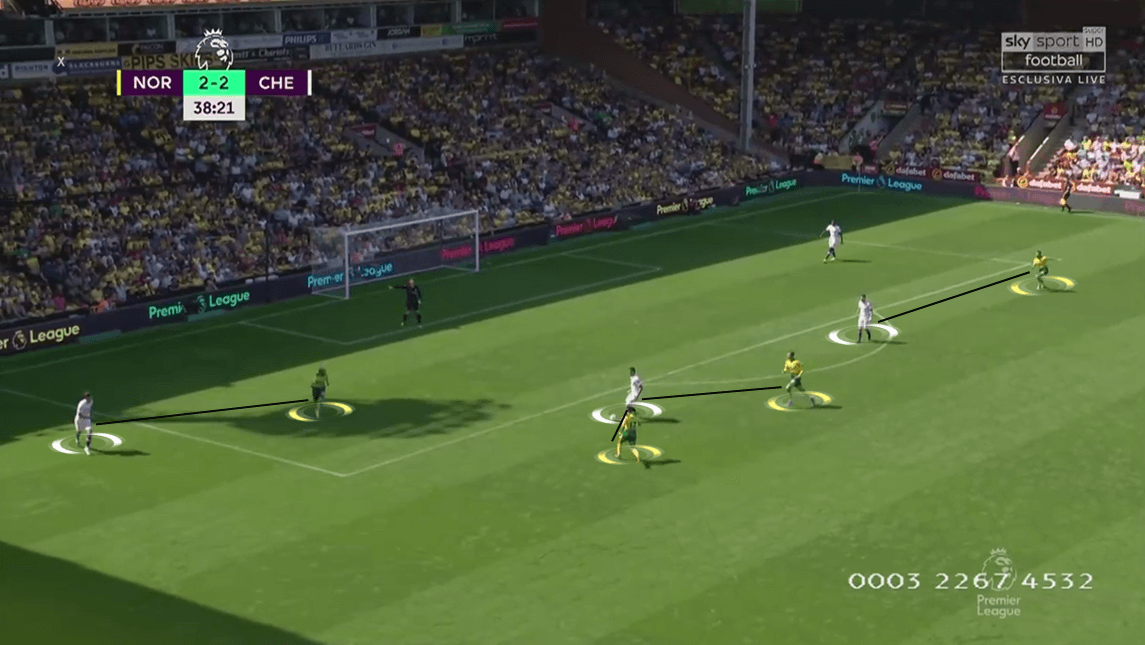
But adopting a high press strategy also meant that they have to take the risk of playing with a high defensive line. They were required to position themselves near the halfway line and cleared any long balls into the space behind them. Aarons and Lewis were players who had the pace to recover from their attacking positions, but this didn’t mean that they were able to track back and formed the back four in time.
Also, with Leitner and Trybull higher up the pitch, it meant they didn’t have a defensive midfielder to screen in front of the defence. This created a problem that Norwich was constantly being threatened throughout the match. There were only Grant Hanley and Ben Godfrey located inside their half and if either Lewis or Aarons managed to retreat, they would only have three players to defend.
While Norwich had the option of counter-pressing the ball carrier when they were tracking back, his teammates would move into spaces and became potential receivers. For instance, Chelsea’s opening goal of the game came from a similar situation. Lewis was able to create a back three with the two centre-backs and shifted towards the ball carrier. At the same time, two other players stayed close to him and suffocated the space around the ball carrier. But when Lewis tried to shift along with Godfrey and Hanley, they left a big gap in between and allowed Mount to play a long ball to Pulišić.
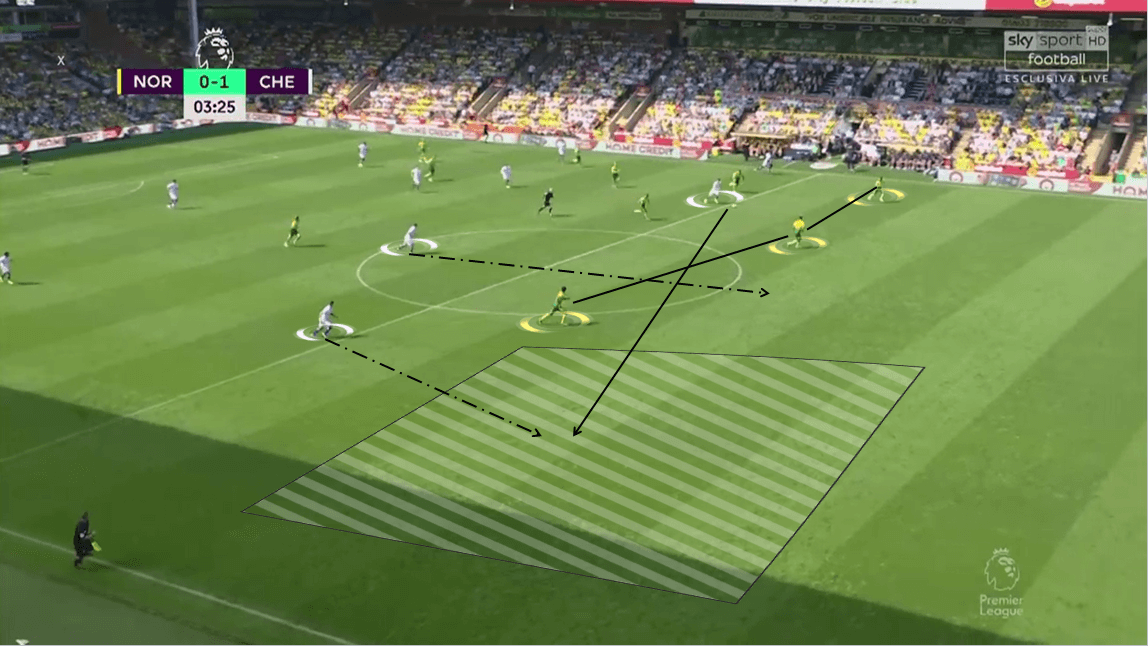
When in possession, though, they tended to build attacks from the back. They had Godfrey, who was comfortable on the ball to lead the build-up. Although Hanley wasn’t a natural ball-playing defender, he was involved a lot by dropping slightly deeper and supported Godfrey if they lost possession.
Furthermore, when the build-up occurred on one side of the pitch, the wing-back from that side stuck to his position and provided a passing option. The position on the other side of the pitch would be occupied by the nearest central midfielder. He moved into the half-space of that area and stayed close to the centre-back. The other one moved flexibly in the central space while creating passing triangles with his teammates.
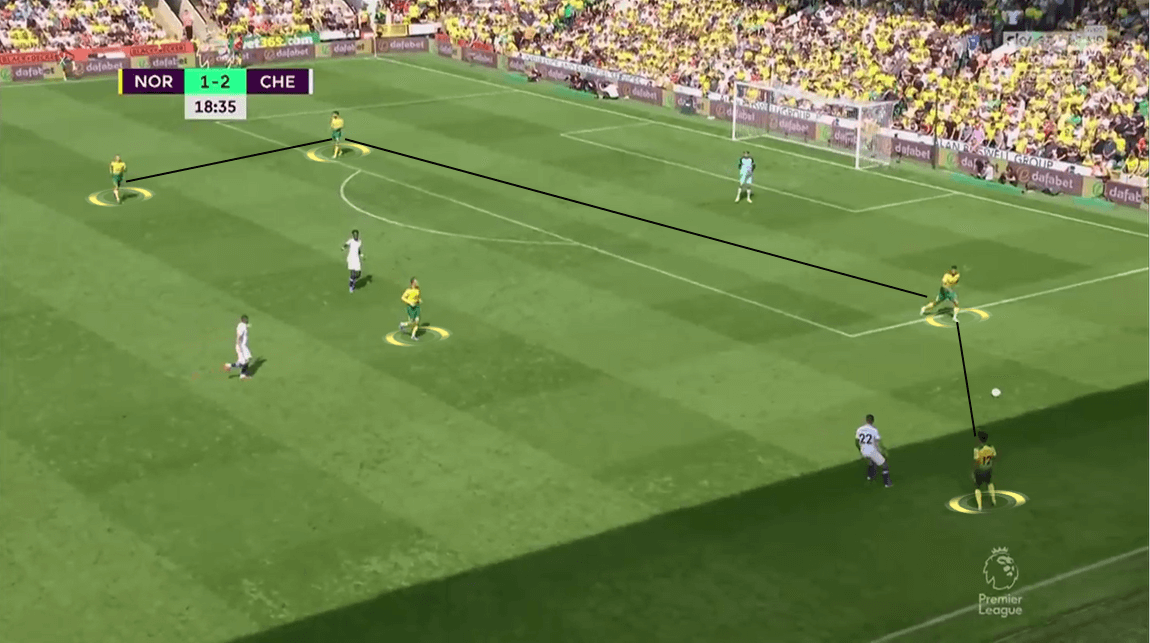
Against Chelsea’s pressure, their build-up strategy was even more crucial as they attempted to circulate the ball out of the overloaded area. In the shot below, the opposition attempted to match Norwich’s number with three players involved in the press. They attempted to cut off passing lanes in between the players and recovered possession for a counter-attack.
While still maintaining that passing triangle, Norwich players also created one more outside of the wide space with the involvement of Leitner. He came short to offer a passing option and form a triangle with Godfrey and Buendía at the same time. The Argentinian received the ball and immediately laid it off to Leitner, who made a back pass towards Krul.
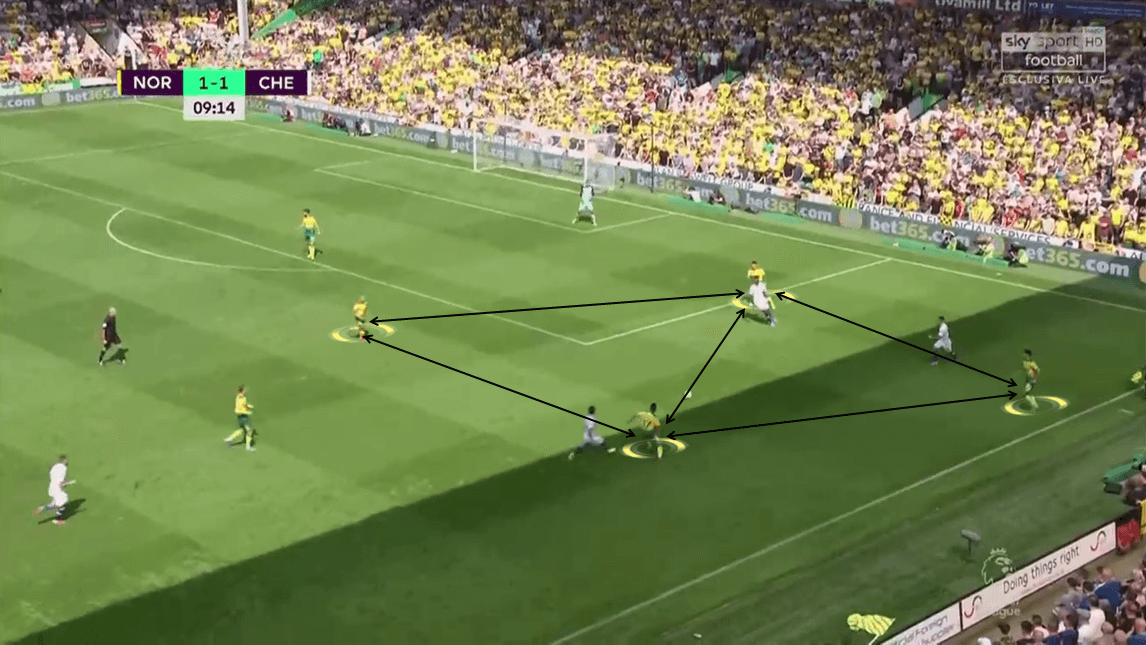
On the other side of the pitch, they were very good at converting their chances into goals. Inside the final third, Norwich players used short and quick combinations to bypass the pressure from the opposition. When one player had possession, his surrounding teammates would move into free spaces and offered to pick up the ball.
In Norwich’s first goal, Buendía dribbled with the ball and entered the final third. He caught the attention of Chelsea defenders and they closed him down. While Puuki played off the shoulder of the defenders and began his run into the box, Cantwell slowly took advantage of the gap between the centre-back. As he edged closer to the area, he acted as an intermediate between Buendía and Puuki. He received the ball, made a through pass to Puuki and scored a tap-in himself.
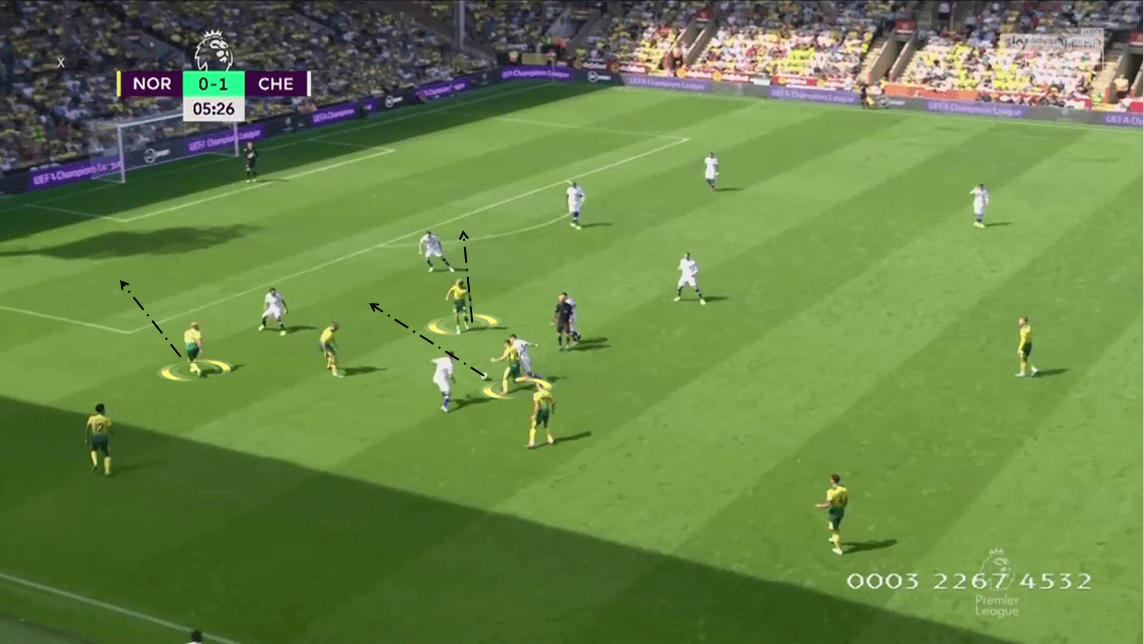
Each of Norwich’s attackers took up their roles in most of their attacks. Playing as the target man, Puuki usually played off the last defender and waited for a through ball. The Finnish striker moved laterally and flexibly in between the gaps of Chelsea defenders. He attracted their attention and even dragged them along to create spaces for his teammates to move in.
Meanwhile, Buendía and Cantwell adopted the role of roaming playmakers. While the former was good in dribbling with the ball and making passes for his teammates, Cantwell could make use of the spaces being left on the field. The trio has shown their influence in the match against Newcastle and picked up where they left off against Chelsea.
But as good as their attacks were in the first half, their chances were limited in the second period. When Chelsea started to increase the pressure, they were forced to sit back and defend against the attackers. Another reason that led to this was that Norwich couldn’t control much of the possession. Between the 45th and the 60th minute, Norwich only 29 % of the ball, meaning they weren’t able to execute their plans.
After that period, the opposition started to loosen the possession and Norwich recovered more of the ball. They created two chances, one of them was Puuki’s second chance of the game and it was on target. His shot was not enough to beat Kepa Arrizabalaga as the Spanish goalkeeper claimed it easily.
Chelsea’s style of play
With the knowledge from his Derby days, Lampard positively approached the game. Firstly, he wanted his side to put an emphasis on building their attacks from the back. Christensen and Zouma were the two centre-backs and were constantly involved in circulating the ball among the block.
Usually, César Azpilicueta would tuck inside and create a back three. Though, he didn’t move centrally and occupied the right half-space during the build-up. The Spanish defender still had the responsibility of making overlapping runs into the opposition’s half.
On the opposite flank, Emerson stayed higher and positioned himself in the centre of the middle third. Similar to Azpilicueta, he overlapped regularly and supported Pulišić in attacks. At the same time, his positioning must also turn him into a possible passing option which allowed the centre-backs to distribute wide against Norwich’s pressure.
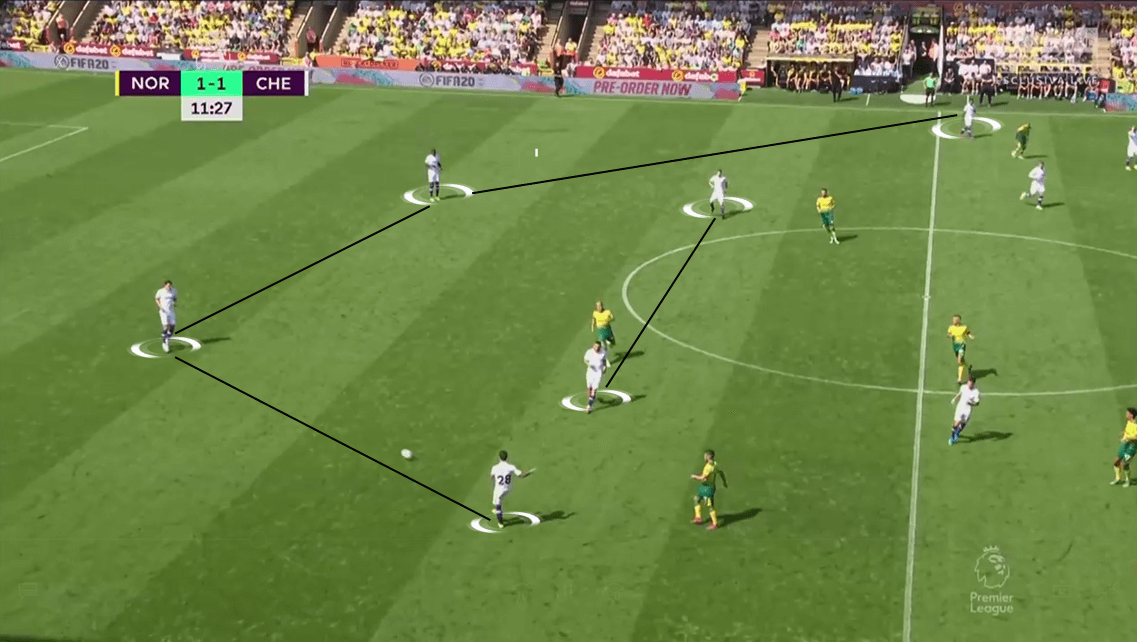
At times, Jorginho dropped deep and moved in between the central area of the passing block. He would create passing triangles with the defenders and allowed them to circulate the ball more efficiently. If Norwich increased their pressing intensity, Kovačić would join the Italian midfielder by staying on the same line as him.
Up front, Ross Barkley operated in between the lines and occasionally moved away from the box when he was off-the-ball. By doing so, he dragged along one of Norwich’s defender and created spaces behind his back. Chelsea used this method to create most of their attacks, which included the opening goal by Abraham.
The former Aston Villa loanee was deployed high up the pitch and attempted to beat the offside trap that Norwich set up on some occasions. In his second goal of the game, he showed his positional awareness. After he received the ball from Kovačić, his attention was turned towards Hanley’s movement as the Scottish defender tried to track back towards the goal. Using a feint, he dribbled past Hanley and Godfrey before hitting the shot into the bottom left corner.
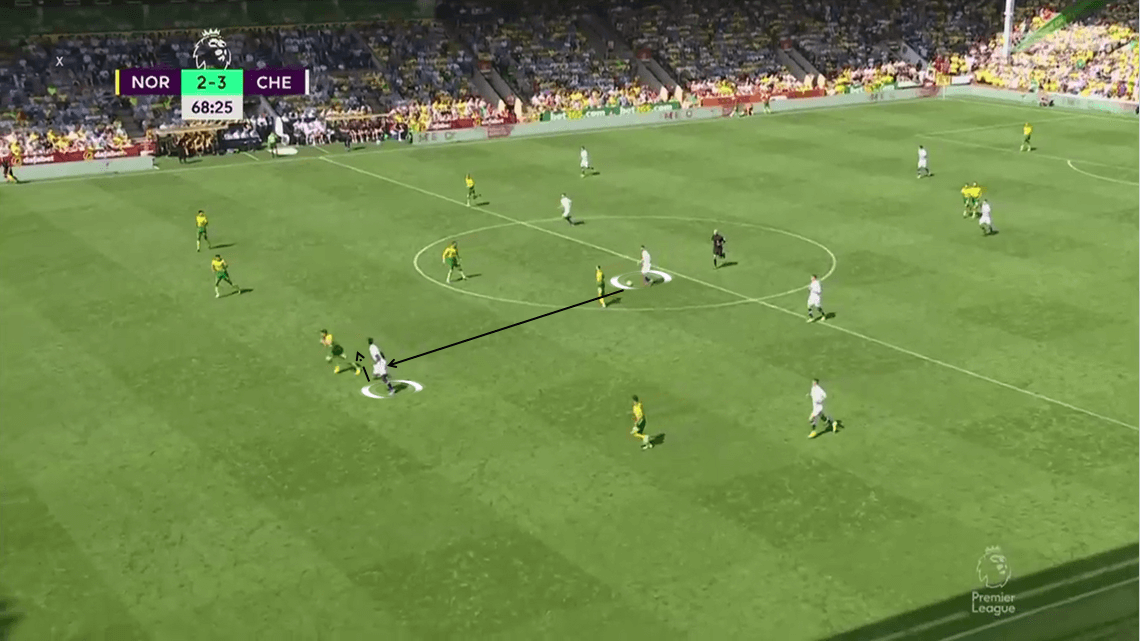
Whenever Chelsea distributed the ball wide, the opposition would create an overload inside that flank to recover possession as soon as possible. This left a big gap centrally which the central midfielders and even Pulišić could move in. If they managed to get the ball out of that area, it would be easy to find those players with a simple through ball or a short pass into their feet.
Their second goal of the game came from a similar situation where Jorginho found the American winger with a through ball. He dribbled on until reaching the edge of the box and then laid the ball off to Mount, who was cutting back in front of Hanley.
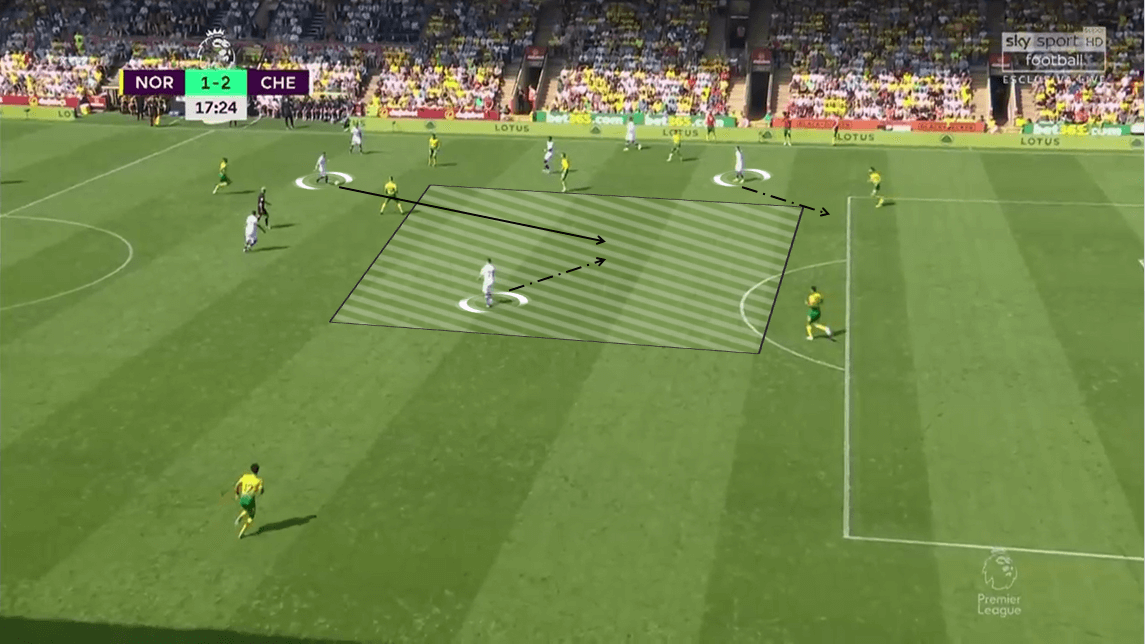
Defensively, they formed a narrow 4-5-1 defensive structure to close the space between the lines and prevented Norwich from reaching the 16-yard box. Using two separate defensive lines, they started the press inside the middle third and retreated in front of the goal.
The midfield line had the responsibility of following the ball carrier and marked the nearest passing options to him. They had the license of recovering possession aggressively but avoided fouls that occurred around the area near the box. The defensive line below stayed more compact compared to the midfielders. While intercepting passes that came towards the zone 14 and their box, the players also tracked the runs of the Norwich players and prevented them from tearing the line apart.
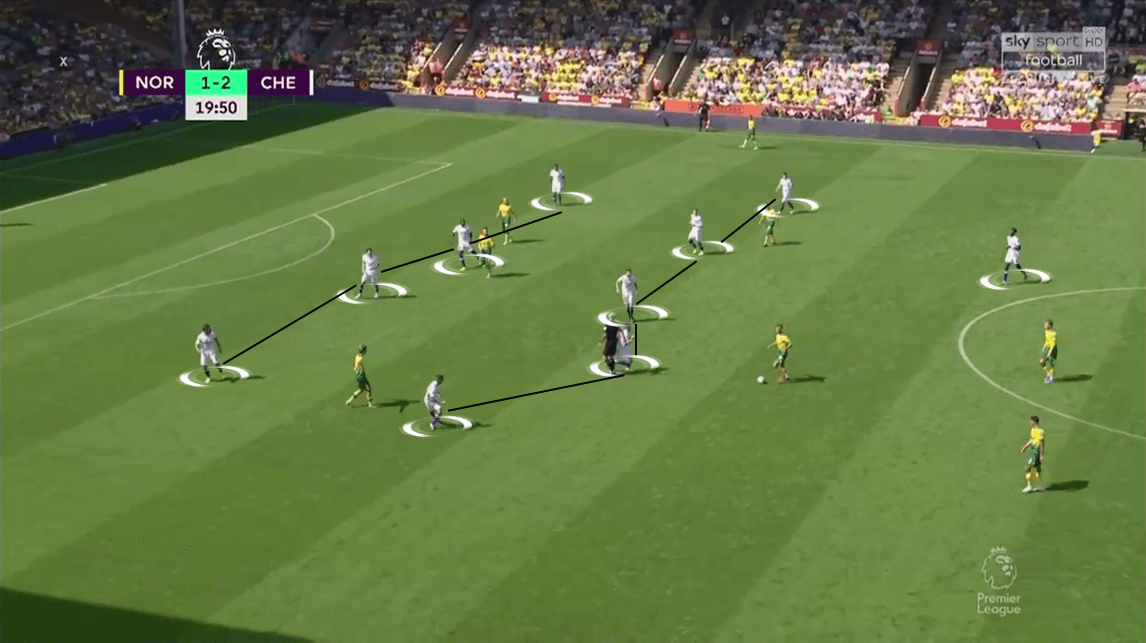
Conclusion
It was a very fascinating match for the fans, especially for Chelsea’s as they watched their team secure all three points. The first-half saw both Abraham and Mount get their names on the scoresheet but also highlighted a few problems that need to be fixed. Lampard’s side went into the second half with a slightly different approach and dominated during the early stages.
Farke’s Norwich didn’t have a bad day, at all, as they played in the way that they intended. They also scored two goals in the process and caused many problems for Chelsea’s defence. But the away side’s dominance in the second half didn’t allow them to find that equalizing goal that they needed. Still, positive signs can be seen from this match and they would want to build on that for the remainder of the season.

If you love tactical analysis, then you’ll love the digital magazines from totalfootballanalysis.com – a guaranteed 100+ pages of pure tactical analysis covering topics from the Premier League, Serie A, La Liga, Bundesliga and many, many more. Buy your copy of the August issue for just ₤4.99 here.

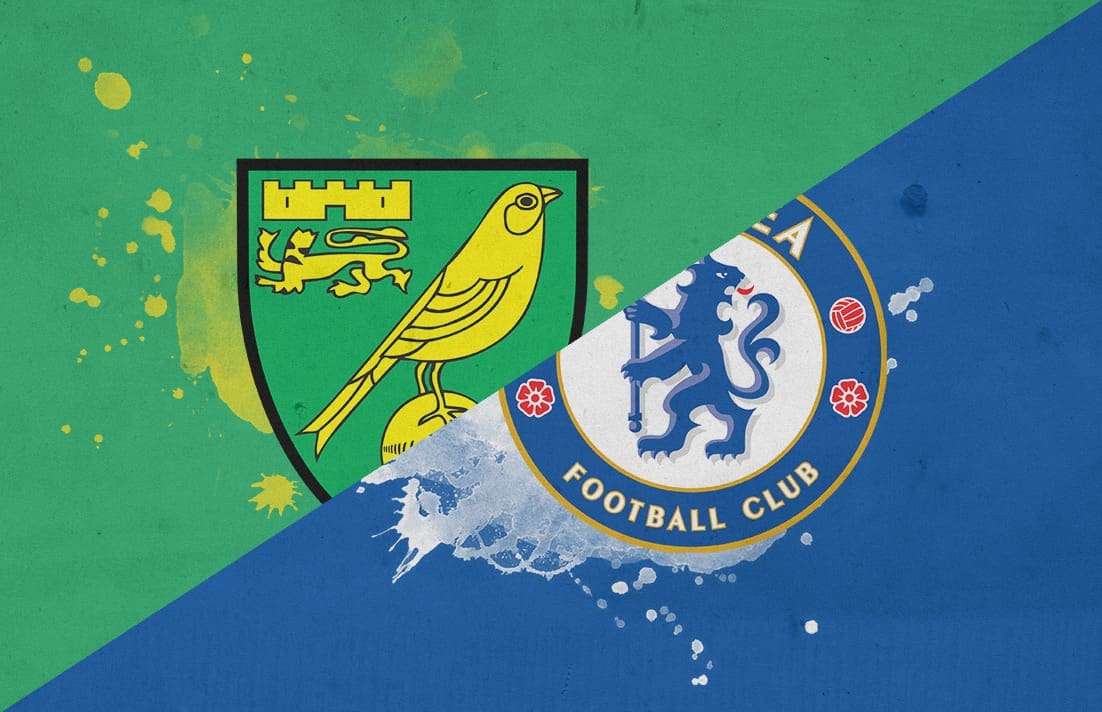



Comments